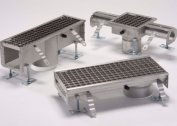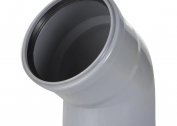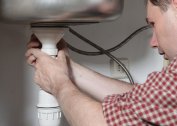City sewage is arranged to collect sewage, human waste products, sedimentary water, as well as household waste. If the system works without problems, and plums undergo high-quality cleaning, even in the metropolis, the natural environment and environmental safety can be preserved.
Types and arrangement of urban sewage
 Citywide sewer pipelines are divided into three varieties:
Citywide sewer pipelines are divided into three varieties:
- Household. It is necessary for the removal of effluents from residential buildings and institutions. It is the largest branching of the city sewer network.
- Industrial. Allows transporting liquid industrial effluents. Such waste is the most dangerous, they require thorough cleaning before disposal.
- Heavy rain. It is used to divert precipitation from the streets. Rain sewer is equipped so that water flows are not only absorbed into the ground, but also sent to the water intake.
The device of the city system differs from the autonomous sewage system in the scale and presence of fecal pumps. After all, it is almost impossible to overtake a large volume of drains to treatment devices. The scheme of the highway includes fan pipes, collectors, wells and stations for wastewater treatment.
For the correct installation of the sewage pipeline in the city, they are guided by the regulatory documents: GOST 21.704-2011 and SNiP "External networks and water supply and sanitation facilities."
The principle of the city highway
How the sewage system works in the city:
- All wastewater, except sludge, is transported through receiving lines to floor branches, then to a vertical riser.
- The riser in the basement is connected to the outlet, and he is to the nearest sewer well. The tank is equipped at a seven-meter distance from the house below the level of freezing of the earth.
- In the well, large debris is held, fat traps are installed. A well tank protects the pipes from blockages.
Depending on the purpose and the total number of connected buildings, several wells are arranged. Pipes are connected there, stage-by-stage liquid purification is performed. If one tank fails, it is temporarily replaced by another. After the passage of the wells, the sewage along the collector pipe is sent to the treatment plant.
The work of the sewage system in urban conditions is supervised by the organizations of housing and communal services. If there is an unpleasant odor in the entrance or a pipe breaks in the basement, you must contact the management company or the housing inspection.
Basic Wastewater Treatment Methods
 The principle of discharge of sewage drains implies separate branches for domestic sewage and stormwater. Wastes should not be mixed, since sedimentary waters are clean enough to be routed to natural bodies of water after minor filtering.
The principle of discharge of sewage drains implies separate branches for domestic sewage and stormwater. Wastes should not be mixed, since sedimentary waters are clean enough to be routed to natural bodies of water after minor filtering.
Other drain liquids require cleaning at specially equipped stations:
- The mechanical cleaning method removes plastic, broken stone, sand and other solid debris from drains. Part of it has already settled in the sand traps of the sewer network. These devices are also mechanical cleaning units and are necessary to prevent line blockages. The principle of purification is based on the force of gravity, due to which heavy debris precipitates at the bottom of filtration plants.
- Chemical and physico-chemical cleaning of sewer drains is based on the interaction of chemicals with contaminants most often of inorganic origin.Harmful substances are oxidized or become neutral, precipitate and are removed. The method is suitable for clarifying industrial effluents, since there is no such amount of active chemical impurities in stormwater or a household network. If the production is harmful, the initial processing of liquid waste must be carried out on the basis of the enterprise.
- Bio-purification is aimed at eliminating pathogens, nitrogenous and phosphorus compounds. Such pollution is most often found in domestic wastewater. To lighten them, methane tanks, biological filters, activated sludge, ultraviolet irradiation and colonies of cleaning bacteria are used.
The mechanical method is used for all types of wastewater in the first place. If chemical treatment is required, mechanics are first cleaned, then bio-cleaned, and only then chemicals are added.
The operation of sewer equipment and the purity indicators of clarified waters must meet all legislative and regulatory criteria. The health, safety and comfort of citizens depends on the proper arrangement of drainage networks.


